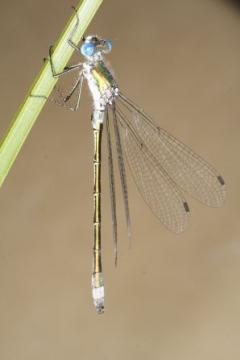Species Account for Lestes dryas
Lestes dryas Scarce Emerald Damselfly
Kirby, 1890
Odonata: Lestidae

Reproduction for study and non-profit use permitted, all other rights reserved.
Taxonomic group: dragonflies & damselflies (Odonata) - Available county data
View time series maps for Lestes dryas
member log-on for taxon report
Status: NS;NT
Essex RDB: Listed
Threat: Regionally Important/Threatened
Images
upload a new image
Essex Red Data List comment
Many Thames Estuary sites are threatened by development and/or neglect. Some apparent decline in coastal marshes of N.E. Essex.
Species text
This metallic green damselfly breeds in shallow ponds and lakes, overgrown canals, ditches and temporary pools, generally neutral to slightly alkaline and where there is an abundance of emergent vegetation. In grazing levels it will tolerate brackish conditions and may be found where sea club rush predominates. This was always a scarce species in southern and eastern England, and during the 1950s and 60s it was lost from many of its known sites and it was feared extinct in the 1970s. It was rediscovered in Essex in 1983 and has subsequently been found in Essex, Kent and Norfolk. The majority of sites are coastal or estuarine marshes, in dykes or pools that are often chocked with emergent vegetation. Sea Club-rush seems to be a common feature to these sites and the species is clearly tolerant of brackish water (Benton, 1988). References
Habitats
Recorded management for locations with Lestes dryas
Recorded substrate and hydrology for locations with Lestes dryas
Why not join the Club, register and add a new species page
Interpretation of distribution maps


















